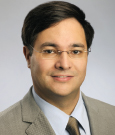Renowned surgical neuro-oncologist Constantinos (Costas) G. Hadjipanayis, MD, PhD, has been named Professor and Chair of the Department of Neurosurgery at Mount Sinai Beth Israel. He has also been appointed as Director of Neurosurgical Oncology for the Mount Sinai Health System and Director of the Brain Tumor Nanotechnology Laboratory in the Tisch Cancer Institute.
Both as a neurosurgeon and a National Institutes of Health–funded scientist, Dr. Hadjipanayis is recognized as a neuro-oncology pioneer, leading cooperative group- and industry-sponsored clinical trials for patients with malignant brain tumors. He was the first in the United States to perform fluorescence-guided surgery for malignant gliomas with the use of a 5-aminolevulinic acid (5-ALA) drug called Gliolan, which can light up otherwise invisible brain tumors in the operating room. His laboratory developed a unique trial for brain tumors using magnetic nanoparticle therapeutic agents that can target brain tumor cells and can also be seen by magnetic resonance imaging.
Dr. Hadjipanayis’ interests include surgery and experimental therapeutics for malignant brain tumors, neuro-endoscopy for pituitary tumors, and colloid cysts. In addition, he performs microsurgery and radiosurgery for tumors of the skull base and spinal cord.
Prior to joining Mount Sinai, Dr. Hadjipanayis was an Associate Professor in the Department of Neurosurgery at Emory University School of Medicine, Chief of Neurosurgery at Emory University Hospital Midtown, and Director of the Winship Brain Tumor Center of Emory. He was also the President of the Georgia Neurosurgical Society and the Southeastern Brain Tumor Foundation.
Dr. Hadjipanayis received his medical degree from Jefferson Medical College. He completed his internship and residency in neurosurgery at the University of Pittsburgh School of Medicine, simultaneously obtaining his doctorate in the Department of Molecular Genetics and Biochemistry. He pursued further advanced training in awake craniotomy techniques and intraoperative cortical/subcortical mapping at the University of California, San Francisco. ■


